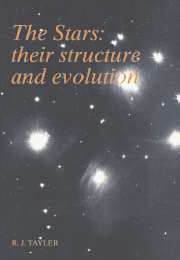Book contents
- Frontmatter
- Contents
- Preface
- Symbols
- Numerical values
- 1 Introduction
- 2 Observational properties of stars
- 3 The equations of stellar structure
- 4 The physics of stellar interiors
- 5 The structure of main sequence stars and pre-main-sequence evolution
- 6 Early post-main-sequence evolution and the ages of star clusters
- 7 Mass loss from stars
- 8 Close binary stars
- 9 Advanced evolutionary phases
- 10 The final stages of stellar evolution: white dwarfs, brown dwarfs, neutron stars and black holes
- 11 Concluding remarks
- Appendix 1 Thermodynamic equilibrium
- Appendix 2 The equation of radiative transfer
- Appendix 3 The pressure of a degenerate gas
- Suggestions for further reading
- Index
8 - Close binary stars
Published online by Cambridge University Press: 05 June 2012
- Frontmatter
- Contents
- Preface
- Symbols
- Numerical values
- 1 Introduction
- 2 Observational properties of stars
- 3 The equations of stellar structure
- 4 The physics of stellar interiors
- 5 The structure of main sequence stars and pre-main-sequence evolution
- 6 Early post-main-sequence evolution and the ages of star clusters
- 7 Mass loss from stars
- 8 Close binary stars
- 9 Advanced evolutionary phases
- 10 The final stages of stellar evolution: white dwarfs, brown dwarfs, neutron stars and black holes
- 11 Concluding remarks
- Appendix 1 Thermodynamic equilibrium
- Appendix 2 The equation of radiative transfer
- Appendix 3 The pressure of a degenerate gas
- Suggestions for further reading
- Index
Summary
Introduction
Throughout the book so far I have only discussed the structure of isolated stars, although I have stressed the importance of binary stars in providing information about stellar masses and radii. Although most stars may be partners in binary or multiple systems, for most of them at least for most of their life history the stars are sufficiently far apart that the internal structure of the stars is not affected by the presence of a companion. The mutual gravitational attraction of the two stars causes them to orbit about their common mass centre but otherwise their binary nature can be ignored. This ceases to be the case if binary stars are initially very close or if they become close during their evolution, possibly because one star expands substantially to become a red giant and as a result its surface gets very close to its companion.
When stars are close there are two distinct types of interaction between them. The properties of the surface layers of one star may be affected as a result of irradiation by the other star. This will be particularly true when one component is much more luminous than the other, when the effect on the less luminous star will be very great. In addition both the gravitational attraction of the companion star and the rapid rotation, which must occur because the stars orbit around one another, will cause a star to deviate substantially from spherical symmetry.
- Type
- Chapter
- Information
- The StarsTheir Structure and Evolution, pp. 177 - 187Publisher: Cambridge University PressPrint publication year: 1994

